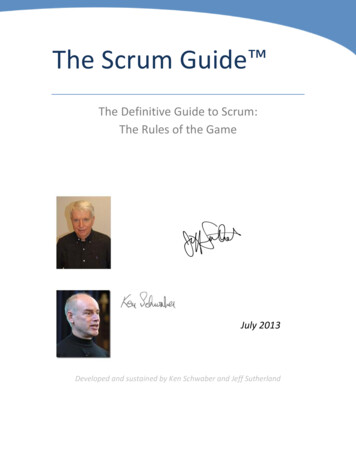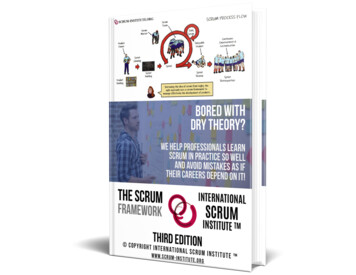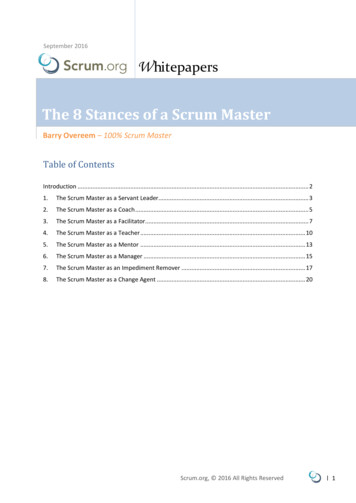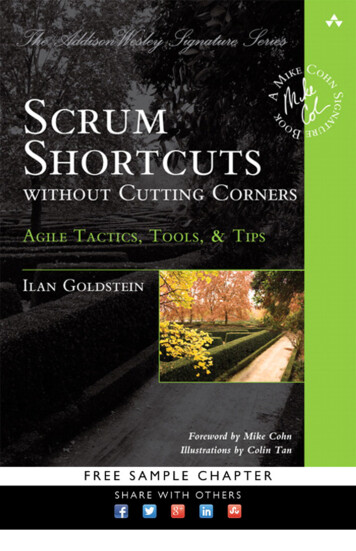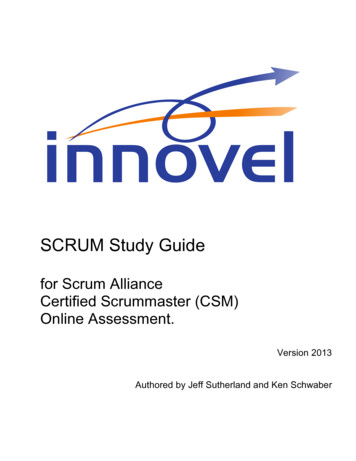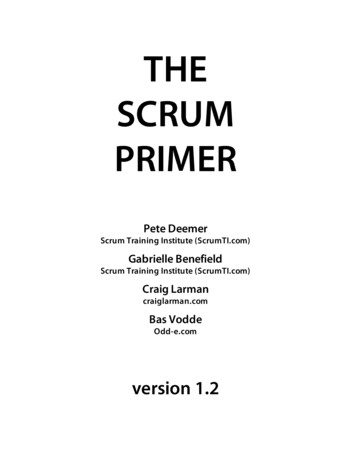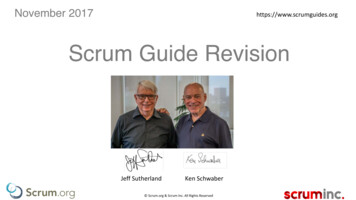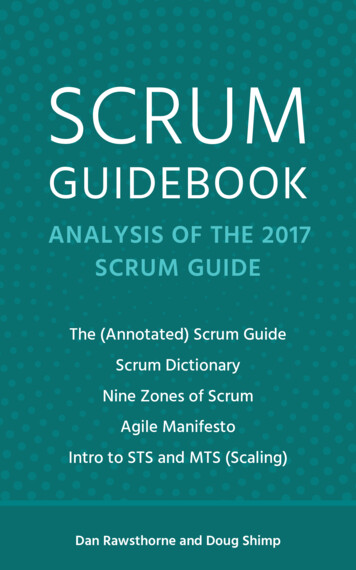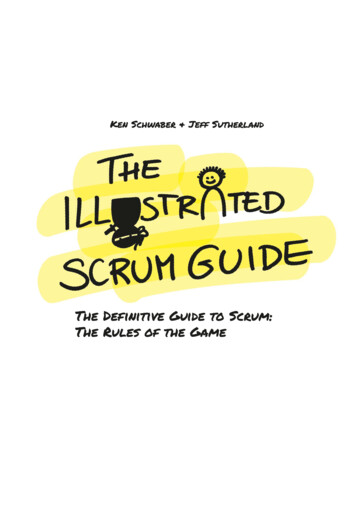
Transcription
Scrum Master Workbook Part 115 weeks of accelerated learningKaren Greaves and Samantha LaingThis book is for sale at http://leanpub.com/ScrumMasterWorkbook1This version was published on 2017-03-06 2016 - 2017 Growing Agile
ContentsAbout the Authors . . . . . . . . . . . . . . . . . . . . . . . . . . . . . . . . . . . . . . .iIntroduction . . . . . . . . . . . . . . . . . . . . . . . . . . . . . . . . . . . . . . . . . .iiHow To Use This Book . . . . . . . . . . . . . . . . . . . . . . . . . . . . . . . . . . . .iiiWeek 1: What Should Scrum Masters Do? . . . . . . . . . . . . . . . . . . . . . . . . .1Week 2: Impediments . . . . . . . . . . . . . . . . . . . . . . . . . . . . . . . . . . . . .4Week 3: Meetings . . . . . . . . . . . . . . . . . . . . . . . . . . . . . . . . . . . . . . .10Week 4: Proactive vs Reactive . . . . . . . . . . . . . . . . . . . . . . . . . . . . . . . .15Week 5: Retrospective . . . . . . . . . . . . . . . . . . . . . . . . . . . . . . . . . . . . .19Want More? . . . . . . . . . . . . . . . . . . . . . . . . . . . . . . . . . . . . . . . . . .22Appendix . . . . . . . . . . . . . . . . . . . . . . . . . . . . . . . . . . . . . . . .23Growing Agile Online Courses . . . . . . . . . . . . . . . . . . . . . . . . . . . . . . .24Growing Agile Books . . . . . . . . . . . . . . . . . . . . . . . . . . . . . . . . . . . . .25About Growing Agile . . . . . . . . . . . . . . . . . . . . . . . . . . . . . . . . . . . . .29
About the AuthorsSam Laing (left) and Karen Greaves (right)We have worked in software our whole lives. With Type A personalities and a strong work ethic,we have both done our share of overtime on death march projects. Eventually we knew we had tofind another way. Agile brought us together when we worked at a company trying to do Scrumfor the first time.In 2012, we took the plunge and started our own business, Growing Agile. Since then we havebeen doing the work that we are passionate about: introducing people to agile and helping teamsimprove. Best of all we have a positive impact on other people’s lives.In the 15 years we’ve been doing agile, one thing has become clear: The Scrum Master role is oneof the most misunderstood and badly implemented parts of Scrum. We’ve made it our personalmission to help change that. A great Scrum Master can make the difference between an okayteam and an awesome team, and we think everyone in this role should be creating awesometeams! Enjoy!
IntroductionWelcome to our Scrum Master Workbook! We hope it will be your companion on your journeyas a Scrum Master for the next 15 weeks.The book is a hands on learning experience that will cover a range of topics we feel Scrum Mastersneed to master. We know that being a Scrum Master is not an easy job, and we are passionateabout helping people on this journey. Through being Scrum Masters ourselves for many years,and coaching many people on the journey, we have a collection of lessons and skills we believeit is vital for Scrum Masters to learn.Our hope is that this book will be like having us as be your personal coach on your journey andfast track your learning by guiding you through these lessons each week. Just like each team isdifferent, each Scrum Master’s journey is different, so what is most important about this book isthat you try things out with your own team and in your environment. Some things we suggestmight work great for you, others might be a complete disaster, that’s okay. That’s how you willlearn.This book is for anyone who is looking to improve as a Scrum Master or agile coach. Because thebook is filled with exercises for you to do, it will make most sense if you have a team (or morethan one) that you can try things out on.The book is written so that it’s applicable if you are a brand new Scrum Master or someonewith 5 years experience looking to revitalise your team. We will cover a lot of the basics, but asexperienced coaches we know that often going back to basics is exactly what experts need.Good luck on your journey, feel free to send us a tweet or email to let us know how it’s going.Twitter: @GrowingAgile¹Email: sam@growingagile.co.za² or karen@growingagile.co.za
How To Use This BookThe first thing we’d like you to do is to print this book. Yes we mean on paper! We live in adigital world and yet we find that tactile tangible things are sometimes so much simpler andbetter. Don’t get us wrong, we aren’t technophobes. We love our fitbits, smart phones and appletv, but for some things paper just works better. We hope having this on your desk will serve asa great reminder to continue your learning. We’ve left plenty of space for you to write in thebook. This means it will be easy to reflect on what you’ve learned over several weeks. The bookis intended to be printed in colour on A4 paper, but feel free to try something different if thatworks better for you.Next we recommend setting aside an hour a week in your calendar for the next 15 weeks. Goput it in your calendar now. Pick a time you aren’t generally distracted and when you will beable to focus and learn. You might even want to book a meeting room for yourself to get awayfrom the interruptions that might happen at your desk.Each chapter is focused on a topic, and the intention is for you to focus on that topic for a week.If an hour once a week is more than you can commit to, feel free to go at your own pace. Youcan take a break at anytime (for example if you go on holiday), then pickup on the next chapterwhen you return. You can also skip around to chapters that are more relevant if you prefer.Each chapter/week is colour coded and structured as follows: An introduction to the topicOne or two blog posts related to the topicAn exercise for you to doA journal page for you to take notes for the weekSome weeks also include cards you can cut out to use for the exercisesWe know that everyone learns differently, so we have provided a variety of materials related toeach topic. Feel free to use only what makes sense to you, and what you have the time for. Don’tworry if you can’t do every exercise, rather focus on what you can learn on the topic.We’ve learned through our other books that although there is a wealth of information and greatideas on the internet about agile, just providing links can be frustrating because links change andcontent gets deleted all the time. For this book we’ve decided to provide the text of the blog postsin a downloadable PDF. This means that you never need to visit a broken link and wonder whatthe article said. We’ve also kept the reading short, so it’s no more than five pages for any onechapter. Feel free to print the Reading PDF out, or to read the short articles on your computer ordevice.Download the Reading PDF here: www.growingagile.co.za/SMWorkbook/ReadingPDF⁴We recommend reading the introduction and blog posts and before doing the exercise. Some ofthe exercises will require you to schedule time with your team or other people to complete eadingPDF
How To Use This BookivOne of the best ways to learn as a Scrum Master is to keep notes on how things are going, whatyou do, and what you notice. Often it takes some time for the impact of our actions to be visible,so being able to reflect over a longer period is a valuable learning tool. For this reason, we’veincluded a journal page each week for you to fill in. We’ll prompt you with some things to thinkabout for the journal each week, but feel free to capture whatever you think might be importantto look back on.When you start we recommend filling in your journal daily. Sometimes by the end of the weekit is difficult to remember what we did earlier in the week. A great tip is to put a reminder inyour calendar for 15 minutes each day to fill in your journal. Once you do this for a few weeks,it will become an easy habit to continue.As agile coaches our favourite meeting is the retrospective. Reflecting on how things have gonein the past is the best way to set ourselves up for success in the future. It’s also a great way toamplify your learning. Because of this, we’ve structured every fifth week to be a retrospective.This is a personal retrospective to do by yourself. The chapters for those weeks will be a littledifferent because they don’t include any reading. They are all colour coded in yellow.
Week 1: What Should Scrum MastersDo?
Week 1: What Should Scrum Masters Do?2What Should Scrum Masters Do?The role of Scrum Master is misunderstood world wide. Many people believe that the ScrumMaster is just a new name for a project manager, which is not the case. This can lead tomisconceptions and uncertainty about what a Scrum Master should be doing.In our experience, even if you’ve been a Scrum Master for more than a year, explaining whatyou do all day is tricky. If you are a new Scrum Master, the role can be overwhelming. You mightfeel you need to do many of things that you really shouldn’t be doing, because they make theteam dependent on you, like updating the team’s task board!Part of the problem is that the Scrum Master role is a completely new role to many of us, socomparisons to other roles are often not useful. The best analogy is to think of the Scrum Masteras a team coach, helping the team get better. Much of what a team coach does is proactive, ratherthan reactive, to prevent problems before they occur.This unfortunately means no one can tell you what you need to do. You need to look foropportunities within your own team and environment. The image below can help you focuson the right things and avoid doing things the team should learn to do for themselves.That is only part of the picture. As new Scrum Masters 50% of your time should be spent learning,reading and sharing what you have learned. I know that sounds daunting 4 hours EVERYDAY! But learning can be fun especially if you have other people doing it with you and youapply everything you learn.
Week 1: What Should Scrum Masters Do?ReadingFor this week’s reading take a look at this list of 42 things a Scrum Master should bedoing⁵. A copy of this article is included in Reading PDF⁶. For additional reading werecommend the book ScrumMastery by Geoff Watts.ExerciseIf you haven’t already – please read How To Use This Book before continuing. Thisweek we would like you to start using the Journal page in this book. Note down whatyou do everyday for this week. This could be a simple list or a more detailed paragraph.We’ll be asking you do this each week for the next few weeks, in preparation for anexercise in week 4. If you think you might forget to do this, then schedule a recurringmeeting for 15 minutes before you leave the office, or the first 15 minutes when youget in. This way you will have set aside time to fill in your journal notes!JournalWrite some notes here on what you’ve done each day this www.growingagile.co.za/SMWorkbook/ReadingPDF3
Week 2: Impediments
5Week 2: ImpedimentsImpedimentsImpediments. Those nasty things that stop you from getting stuff done. Nope. Impediments don’tjust stop you from getting stuff done. Impediments are ANYTHING that prevent you from goingas FAST as possible.Think about that carefully for a moment. That might be faster than you have even gone before.Some impediments are “just the way things work around here”.The question “Do you have any impediments?” during a dailyscrum or standup rarely solicits any answers. Usually onlyblockers (things preventing work) get mentioned. Instead, listento people’s language in the daily scrum. Any hint of uncertaintymeans there is potentially an impediment that can be resolved.We have created a list of “impediment words”. Listen for thesewords in your next daily scrum and see how many potentialimpediments you can spot. Ask clarifying questions to uncoverwhether it is a problem, or if someone is just using uncertainlanguage out of habit. Start to notice how often you and thosearound you use uncertain language.There is a cutout of these words for you later in the chapter.Not every impediment needs solving right now. The big hairyones will most likely take months or even years to fully solve. Your aim is to make them lesspainful for your team. Chip away at them one small step at a time. The best way to do this is tosource multiple ideas from the team. Many heads thinking of potential solutions is always betterthan one. You could also seek help from outside the team, perhaps other teams have alreadyfaced and conquered a particular impediment.The problem solving tree is a great technique to help identify potential solutions for impediments.We have included this technique in this week’s reading.ReadingFor this week’s reading take a look at two blog posts from our blog: What Should aNew Scrummaster Be Doing⁷ and The Problem Solving Tree⁸.A copy of these articles is included in Reading a/SMWorkbook/ReadingPDF
Week 2: ImpedimentsExerciseWrite down some of the impediments you have noticed in your daily scrum. Don’tworry about how you will solve these yet, just list them. For example: A team memberis waiting for the Product Owner to get back to him before he can complete his work.6
Week 2: ImpedimentsExercisePick one of the impediments you listed that you would like to resolve. Use the rest ofthis page to draw a problem solving tree for that impediment. Try to think of lots ofsmall things you can do to make the impediment have less impact, if it is difficult tosolve completely. Now get out there and try some of the things you’ve identified.7
Week 2: ImpedimentsJournalAs with last week, use your journal to write down what you’ve done this week. Alsowrite down which ideas you tried to solve the impediment, how it worked, and whatthe impact has been on your team.8
Week 2: ImpedimentsFor Your ToolboxCut this out and add it to your toolbox to use with your team.9
Week 3: Meetings
11Week 3: MeetingsMeetingsTime is money. We all know it. And yet the vast majority of organisations suffer from time wastewhen people sit in a meeting and don’t actually get any value. That is time from each of theirdays that they have lost. Eliminating this waste or even minimising it could save some companiesmillions.As a bonus – not wasting your time waiting for meetings to start or being bored during them,will leave you and your team much happier!Meetings are necessary. Face to face communication is proven to be vastly more effectivethan any other form of communication. We need to understand how to make meetings moreproductive.Luckily – with just a few tips – you can do this as a Scrum Master. What you will notice is thatif you implement these tips, other people will start changing their behaviour too.TIPS Always prepare for a meeting.Always have a purpose for the meeting and an intended outcome.If attendees need to bring or prepare something, tell them in advance.Always start meetings on time and close the door.Latecomers are welcome, but must open the door. Don’t catch them up on what has beendiscussed, they will learn to be on time if they don’t want to miss anything.Always end meetings on time. If the desired outcome has not been achieved then have adiscussion as to when to address this before the end of the meetingPlan meetings to end at 5 minutes to the hour (e.g. 9:55am) to allow participants time toget to their next meeting on time.Ensure that you facilitate the meeting and keep it on topic.Don’t multitask in meetings by checking your phone, tablet or laptop. Pay attention to theperson talking, and take notes on paper. Taking notes on a laptop can make people thinkyou are checking email, even if you aren’t.If the desired outcome is achieved before the end of the meeting, end the meeting early.The above tips allow people to have FOCUS. They demands RESPECT and require COMMITMENT, COURAGE and OPENNESS. Do these sound familiar?
Week 3: MeetingsReadingFor this week’s reading take a look at this blog post on Meeting Addiction¹⁰.A copy of this article is included in Reading rowingagile.co.za/SMWorkbook/ReadingPDF12
Week 3: MeetingsExerciseThe best way to improve your meetings is to reflect on what happened in the meetingas soon as possible afterwards. Think about things that worked well and why that was,as well as things that went badly and try to understand why and what you could doinstead.For this week schedule 10 min in your calendar after every meeting to reflect. Answerthe following questions for each meeting.1) Was the meeting valuable? Why or why not?.2) Did you pay attention all the time? Why or why not?.3) Did everyone else pay attention all the time? Why or why not?.4) Which parts felt great? Why?.5) Which parts felt awkward or odd? Why?.6) What one thing can you change to make the meeting more valuable?.13
Week 3: MeetingsJournalWrite down in your journal, which of the tips you’ve tried in your meetings and whathappened as a result. Also note down what you did this week as you’ve done for thepast 2 weeks. We’ll be using this information next week.14
Week 4: Proactive vs Reactive
16Week 4: Proactive vs ReactiveProactive vs ReactiveThink about your average day at the office. How would you rate it on a scale of 1 to 10, when1 is calm and peaceful and 10 is hectic and crazy? If you are running around everyday doingwhat we call “the headless chicken dance” then you are likely mostly being reactive. This meansyou tackle problems as they arise, and they usually arise a lot. As explained in the first week,part of the challenge of being a ScrumMaster is that your job should be proactive, rather thanreactive. Instead of constantly putting out fires, you should instead be preventing them from everbecoming fires.The hardest part of being proactive, is that it is not obvious what you need to do,and if you are doing it well, almost no one notices because everything just runs smoothly. If yourenvironment is in a constant state of crisis, you need to consciously create space and time to beproactive. Continuing to be reactive only perpetuates the crisis state.Let’s look at a story. Kate is a Scrum Master and her team is working well together. Kate feelsshe is proactive a lot of the time, but the times she feels crazy are just before a release. It seemsshe needs to be in 10 different places at once for the 2 weeks before a release. Some of the thingshappening during those two weeks are: Her PO needs all the critical bugs fixed Her team isworking on bugs but as individuals so they can cover more ground Every release to the testingenvironment seems to bring new critical bugs The closer they get to release date the more stressedeveryone gets The team works overtime to fix more bugs.Kate has noticed when she (and her team) are reactive and listed her observations. Now she canstart working on these proactively. Perhaps she can investigate Agile Testing in order to preventbugs. Perhaps her team can try releasing to production more frequently so that smaller pieces ofwork go in. Maybe the team can try fixing bugs as soon as they are found rather than leavingthem to the end of the release.As you can see by the story above being proactive means slowing down and observing the chaosin order to make some some changes.ReadingFor this week’s reading take a look at these three blog posts: Being Proactive vsReactive¹², Customer Service¹³ and Proactive Reactive¹⁴.A copy of these articles is included in Reading .co.za/SMWorkbook/ReadingPDF
Week 4: Proactive vs ReactiveExerciseTake a look at the journal entries you’ve been keeping for the past three weeks. Nextto each thing that you did, mark whether it was proactive or reactive.1) What % of the time were you proactive vs reactive?.2) Now map these tasks onto the quadrants in the Toolbox section. Be sure to read theblog posts for more detailed instructions. What tasks could you get rid of or delegateto make more time to be proactive?.JournalWrite down some ideas of what you plan to do this week to be more proactive. At theend of the week, reflect on how it went.17
Week 4: Proactive vs ReactiveFor Your ToolboxCut this out and add it to your toolbox to use with your team.18
Week 5: Retrospective
20Week 5: RetrospectiveRetrospectiveFor this week, instead of covering a new topic we would like you to do a personal retrospectiveof the last 4 weeks (or since you started this book). You can choose the focus to be as broador narrow as you like. It could be for everything in your life, or just your learning as a ScrumMaster.Try to do this in a quiet place where you won’t be disturbed and set aside about an hour. Foreach question try to spend 15-30 minutes on it. If you get stuck after 5 minutes don’t rush ahead,just sit and think, more will come. Feel free to browse through your journal entries to remindyourself of what you’ve done.What’s working? What did I do right? What am I proud of?.What’s not working? What could be improved? What are my biggest opportunities for growth?.How can I fix what’s not working for a better result? What specific things can I focus on nexttime?.
Week 5: RetrospectiveJournalUse your journal this week to keep track of what you change because of yourretrospective.21
Want More?If you have enjoyed the last few weeks of guided Scrum Master learning and want more, whynot get the full book?The full workbook includes 15 weeks of accelerated learning!You can find it here: leanpub.com/ScrumMasterWorkbook1
Appendix
Growing Agile Online CoursesWe offer several online courses aimed at Scrum Masters, Product Owners and Agile Teams.If you are ready to get a taste of what our online courses are about sign up for our FREE fiveweek Scrum Master¹⁷ or Product Owner¹⁸ email course.Our online courses are a little different to regular online video courses. We’ve applied theprinciples of Training From The Back of The Room to our online materials. That means eachcourse comes with a workbook and exercises for you to do, as well as video’s to watch andtechniques that you can use with your teams. Each activity is intended to deepen your knowledgeof an area, so we suggest doing the course over a few weeks and taking the time to do all theexercises.Take a look at our offerings here ne-courses/
Growing Agile BooksThe Growing Agile Coach’s Guide SeriesThis series provides a collection of training and workshop plans for a variety of agile topics.The series is aimed at agile coaches, trainers and ScrumMasters who often find themselvesneeding to help teams understand agile concepts. Each book in the series provides the plans,slides, workbooks and activity instructions to run a number of workshops on each topic. Theinteractive workshops are all created using techniques from Training from the Back of the Room,to ensure participants are engaged and remember their learnings after the workshop.The series is available in a bundle on Leanpub²⁰, or you can purchase the books e
26Growing Agile BooksGrowing Agile: A Coach’s Guide to Training ScrumWe have been training teams in Scrum for about three years. During this time we have spentmany hours preparing training plans and creating workbooks, flipcharts and slides. This bookwill help you plan and deliver interactive, fun Scrum training for anything from a short workshopon a particular topic to a full two-day course.Growing Agile: A Coach’s Guide to Training Scrum is available on Leanpub²¹.A Coach’s Guide to Agile RequirementsOur requirement workshops are aimed at different stakeholders ranging from business, toProduct Owners and teams. This book is a collection of some of those workshop and can beused to help improve the way you think about and communicate agile requirements.Growing Agile: A Coach’s Guide to Agile Requirements is available on Leanpub²².Growing Agile: A Coach’s Guide to Mastering BacklogsOften Product Owners can’t see the forest for the trees and there are so many items in theirbacklog and not enough hours in the day to groom it. We run short workshops where we workwith the Product Owner’s actual backlog. The workshop is a working session, and an hour laterthe Product Owners emerge with an improved backlog.Growing Agile: A Coach’s Guide to Mastering Backlogs is available on Leanpub²³.Growing Agile: A Coach’s Guide to Release PlanningWe often hear people say “We’re agile, we don’t need a plan”! or even worse “We can’t plan”.This is just not true. We run Release Planning workshops with many organisations. This book is acollection of our workshops that will help you run similar workshops to create agile release plans.We include teaching points on a range of techniques like Story Mapping and release burnups tohelp you explain to other’s how to use these methods effectively.Growing Agile: A Coach’s Guide to Release Planning is available on Leanpub²⁴.A Coach’s Guide to Agile TestingIf a team believes they are agile, but nothing has changed about the way they test, then thereis still much to learn. We teach 5 key principles that explain why agile testing is fundamentallydifferent to traditional testing.This books includes a collection of workshops to help teams graspthese principles and adopt an agile testing mindset. It’s not just for testers. A key part of eleasePlanning
27Growing Agile Bookstesting is that the whole team is involved, so we always run these workshops with everyone inthe team.Growing Agile: A Coach’s Guide to Agile Testing is available on Leanpub²⁵.Growing Agile: A Coach’s Guide to FacilitationIt’s taken us several years to master the skill of facilitation, and it continues to amaze us howfew people learn the skill, or even understand what it means. People spend much of their livesin meetings, and yet so many meetings lack facilitation. We hope the collection of tips andtechniques in this book will inspire you to grow your own facilitation skills and improve themeetings in your organisation.Growing Agile: A Coach’s Guide to Facilitation is available on Leanpub²⁶.Other books by Growing AgileFlowDo you have a never-ending to do list and not enough hours in the day? Imagine gettingeverything on your to do list done without stress or worrying. Imagine being twice as productivein half the time.We have over 30 proven tips and techniques to help you achieve a state of flow, where time standsstill and productivity soars. With these tips you will deliver value to your customers sooner inpractical and simple ways. You will also be happier and less stressed.Flow is available on leanpub.com/helpworktoflow
28Growing Agile BooksCollaboration GamesAdd an element of fun to your meetings or workshops using these 12 short games that teachprinciples of collaboration.Collaboration Games is available on Leanpub²⁸.Who is Agile in South AfricaThis book is based on the original Who Is Agile book, only this is a regional version for SouthAfrica. It’s a collection of interviews with passionate South African agilists.Who is Agile in South Africa is available on uthAfrica
About Growing AgileAt Growing Agile we help companies build great teams that create exceptional products. We areagile coaches passionate about helping you get the results you are looking for.We are based in Cape Town, South Africa, but work with clients from all over the world. Weprovide remote sessions for individuals or groups, as well as online courses for Scrum Masters,Product Owners and Teams. Find out more about us at www.growingagile.co.za. Our personalgoal is to help influence a million people on their path to becoming agile coaches. Our books andvideos are ways we can spread that influence further than what we can in person. We are alsoexploring new ways to do this. One of our latest projects is www.AgilePath.me. A communityresource of links, courses, books, and ideas to help you find your own learning path as an agilecoach. If you would like to stay in touch and hear about our new ventures, please sign up to ourmonthly newsletter³⁰.³⁰http://eepurl.com/xVP6D
book is filled with exercises for you to do, it will make most sense if you have a team (or more than one) that you can try things out on. The book is written so that it’s applicable if you are a brand new Scrum Master or someone with 5 years experience looking to revita
